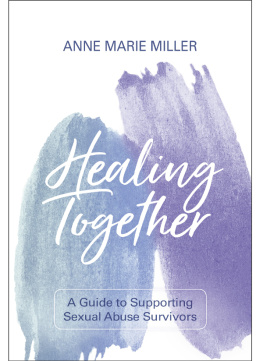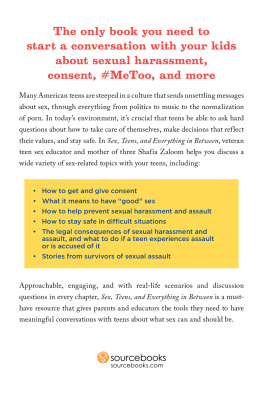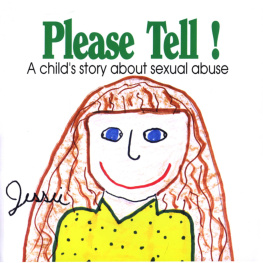Published in 2016 by The Rosen Publishing Group, Inc.
29 East 21st Street, New York, NY 10010
Copyright 2016 by The Rosen Publishing Group, Inc.
First Edition
All rights reserved. No part of this book may be reproduced in any form without permission in writing from the publisher, except by a reviewer.
Library of Congress Cataloging in Publication Data
Byers, Ann.
Sexual assault and abuse / Ann Byers. -- First edition.
pages cm. -- (Confronting violence against women)
Includes bibliographical references and index.
ISBN 978-1-4994-6042-1 (library bound) -- ISBN 978-1-4994-6043-8 (pbk.)
- ISBN 978-1-4994-6044-5 (6-pack)
1. Sex crimes--Juvenile literature. 2. Child sexual abuse--Juvenile literature.
3. Women--Violence against--Juvenile literature. 4. Women--Crimes against
-Juvenile literature. I. Title.
HV6556.B94 2016
364.153--dc23
2014048787
Manufactured in the United States of America
CONTENTS
INTRODUCTION
CHAPTER 1
The Many Forms of Sexual Violence
CHAPTER 2
Sexual Violence Against Children
CHAPTER 3
Electronic Sexual Abuse
CHAPTER 4
Sexual Violence in Relationships
CHAPTER 5
If It Happens
GLOSSARY
FOR MORE INFORMATION
FOR FURTHER READING
BIBLIOGRAPHY
INDEX
INTRODUCTION
T iffany had no reason to fear her boss. They went to the same church and she had known him for years. When he offered her a job at his bookstore, she jumped at the chance. At sixteen, she wanted to buy a car, and this job would help her afford it. But when he started asking personal questions, she felt uncomfortable. She was really surprised when he asked, Tiffany, are you a virgin? He complimented her on her decision to wait until marriage, and she decided he was just being friendly. Still, the comment bothered her.
A few days later, when he asked if she had a boyfriend, she felt that uncomfortable twinge again. In the days and weeks that followed, when her boss told her she was pretty or smart or talented, she felt awkward. But she was also flattered that a nicelooking man in his thirties noticed her. It was all very confusing.
One day her brother, who was her means of transportation, had to work late. Her boss offered to give her a ride home. She thought nothing of it until he said, Lets stop at my place. He had some books to show her. The uncomfortable feeling returned, but she reasoned it away. He had never done anything to her, and he was her boss. She liked her job. So she agreed.
At his house, he kissed her gently and led her to his bedroom. Later she said, I didnt want it to happen. But at the same time, it seemed inevitable. She was too mixed up and frightened to do anything but follow his lead. She felt trapped. And she thought it was all her fault.
Sexually suggestive words and looks sometimes lead to harassing touches and actions. If someones behavior makes you feel uncomfortable, say something.
After that day, Tiffanys boss gave her many rides home. Once, when she thought she might be pregnant, she was stunned by his cold, selfish, and cruel response. For a year, she lived not only with the sex, but also with anger, self-hatred, and shame. She kept the truth hidden from her parents, her brother, and everyone else.
Many years later, she poured out her hurt to a counselor. The counselor helped her see that her boss had taken advantage of her and that she was not to blame. After many counselling sessions, she found peace and healing and was able to put the painful ordeal behind her. Now she shares her experience as a way to help and warn others about sexual predators.
Tiffanys story, which she told under an assumed name to Christianity Today, illustrates some common themes in the ugly picture of sexual violence. For one, predators are very seldom strangers; they are usually people the victim knows and trusts. Their assaults are not spontaneous acts, but are carefully planned. The predator does not love the victim; he uses her. And he leaves her with deep and undeserved guilt and humiliation.
Like Tiffany, many victims of sexual abuse are reluctant to tell anyone about their secret nightmare. But seeking help and talking with a trusted person are the first steps toward healing. This resource was written so people will know that help is available. It was written so that victims can overcome the violence and abuse they experienced and move from victim to survivor.
CHAPTER 1
The Many Forms of Sexual Violence
S adly, Tiffanys story is not rare. The Centers for Disease Control and Prevention (CDC) reports that almost one in five women in the United States has been raped at some point in her life. The Rape, Abuse, and Incest National Network (RAINN) estimates that a sexual assault occurs once every two minutes. That makes sexual assault one of the biggest categories of crime in the United States.
The U.S. Department of Justice defines the crime of sexual assault as any type of sexual contact or behavior that occurs without the explicit consent of the recipient. Lets take that definition apart. It has three components: sexual contact, sexual behavior, and without explicit consent.
Sexual Contact and Sexual Behavior
Sexual contact occurs when a person touches the sexual areas of another person. That means anything around the private parts and the breasts. Obviously intercoursehaving sexis sexual contact. So is fondling, or intentionally rubbing, private body parts. To meet the definition, the contact does not have to be skin to skin; if one person touches another sexually through clothes, the touching is sexual contact. If done without consent rape, oral and anal sex, and fondling are crimes.
Spying on people while they are undressing may seem harmless, but it uses other people to satisfy the viewers personal desires. It robs victims of their right to privacy.
Sexual behavior encompasses actions that do not necessarily involve physical contact. Actions that make people feel good sexually are sexual behaviors even if there is no physical touch. When those actions involve other people without their consent, they are forms of sexual assault.
One example of noncontact sexual behavior is voyeurism. Voyeurs are peeping Toms; they seek sexual enjoyment from looking at a naked or partially undressed person or watching people engaged in sexual activity. They might peep secretly, without letting the other person know they are looking, or they might force or persuade their victim to perform for them. Either way, the behavior is criminal.
The flip side of voyeurism is exhibitionism. Instead of looking at others, exhibitionists want others to look at them. They get sexual pleasure by exposing themselves, either completely naked or uncovering private parts. Exhibitionism is also called flashing or indecent exposure. Most exhibitionists do not actually want physical contact with their victims. They are satisfied with the shocked reactions to their behavior. Exhibitionism is often a misdemeanor (a minor crime), but it is still a crime.
Other noncontact sexual behaviors involve pornography. Pornography is the depiction of sexual behavior for the primary purpose of arousing sexual interest. It could be a photograph, a video, or a text. Merely possessing pornography is not necessarily illegal. However, both possessing and distributing pornography become sexual assault, and therefore criminal, when the pictures are of children or are taken without consent.

















